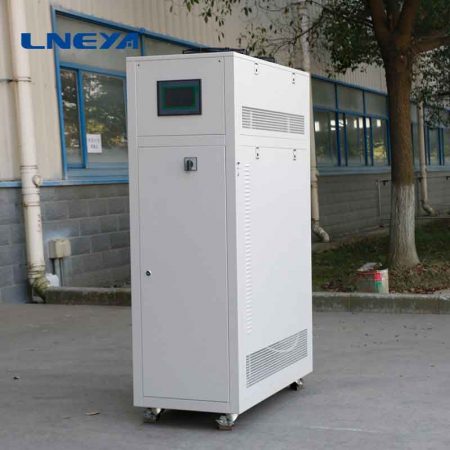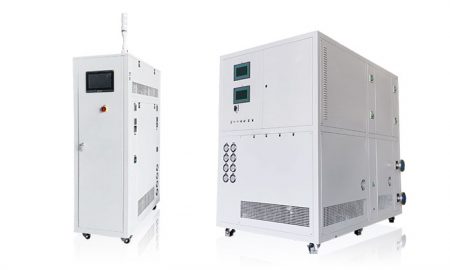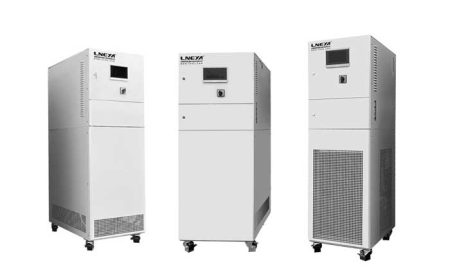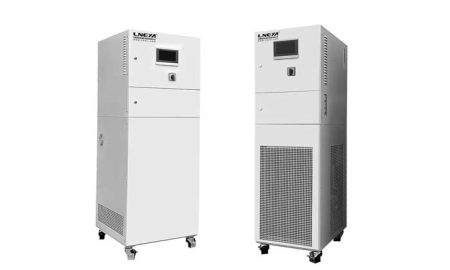Cold Water Recirculating System
완벽한 온도 제어 솔루션을 위해 지금 바로 문의하세요.
Overview of cold water recirculating system
The cold water recirculating system is configured for water cooling of production equipment. A cooling water system that uses water as the cooling medium and circulates it. After the cold water flows through the production equipment that needs to be cooled (often called heat exchange equipment, such as heat exchangers, condensers, and reactors), the temperature rises. If it is discharged immediately, the cold water is only used once (called a DC cooling water system). When the heated cold water flows through the cooling equipment, the water temperature will drop back, and the consumption of cold water will be greatly reduced, often saving more than 95%. Cooling water accounts for about 70% of industrial water consumption, so cold water recirculating system plays a role in saving a lot of industrial water.

Cold water recirculating system generally consists of the following parts:
1. Heat exchangers in the production process
2. Cooling the structure
3 circulating water pump and sump.
Cooling structures for cooling water cooling treatment generally use cooling pools or cooling towers. Its working process is as follows: the circulating water is transported by the water pump to the water supply main pipe, and then enters each production equipment that needs cooling treatment, flows through the parts that need to be cooled, and then collects into the return water main pipe, and sprays downwards through the water distribution pipe above the cooling water tower . When the fan on the top of the cooling water tower is running, the return water flows back into the water storage tank after sufficient heat exchange with the air flow in the packing layer.
Classification of cold water recirculating system
Cooling equipment can be divided into open type and closed type, so cold water recirculating system is also divided into open type and closed type. Open systems are more complex to design and operate.
Open type: There are two types of cooling equipment, cooling pools and cooling towers, both of which mainly rely on the evaporation of water to reduce the water temperature. Fans are often used in cooling towers to promote evaporation, and cooling water is often blown away. Therefore, the open cold water recirculating system must supply fresh water. Due to evaporation, the circulating water is concentrated, and the concentration process will promote salt scaling. Make-up water has a dilution effect, and its flow rate is often determined according to the concentration limit of circulating water. Usually the amount of added water exceeds the amount of water lost by evaporation and wind, so some circulating water (called sewage) must be discharged to maintain the balance of water.
In an open system, due to the contact between the water flow and the atmosphere, dust, microorganisms, etc. enter the circulating water; in addition, the escape of carbon dioxide and the leakage of materials in the heat exchange equipment also change the water quality of the circulating water. For this reason, circulating cooling water often requires treatment, including sediment control, corrosion control and microbial control. The determination of the treatment method is often related to the water quantity and quality of the make-up water, as well as the performance of the production equipment. When multiple agents are used, possible chemical reactions between agents should be avoided.
Closed The closed cold water recirculating system adopts closed cooling equipment, the circulating water flows in the tube, and the outside of the tube usually uses wind to dissipate heat. Except for the material leakage of the heat exchange equipment, there are no other factors that change the water quality of the circulating water. In order to prevent the formation of salt scale in the heat exchange equipment, sometimes the cooling water needs to be softened. In order to prevent heat exchange equipment from being corroded, corrosion inhibitors are often added; when using high-concentration and highly toxic corrosion inhibitors, pay attention to safety, and the cooling water discharged during maintenance should be properly disposed of.
이메일: info@lneya.com WeChat ID: +8615251628237 WhatsApp: +86 17851209193
 정밀 냉각기 / 소형 냉각기 (맞춤형 디자인)
정밀 냉각기 / 소형 냉각기 (맞춤형 디자인)
이 냉각기는 다양한 산업 및 실험실에서 널리 사용될 수 있으며 맞춤형 설계를 지원합니다.
| 온도 범위 | -18°C ~ +30°C | +5°C ~ +35°C 시리즈 |
| 냉각 용량 | 0.35 ~ 0.9kW | 1.8 ~ 50kW |

재순환 냉각기 (맞춤형 디자인)
당사의 재순환 냉각기는 저온 냉동 기술을 채택하고 온도가 -120℃까지 낮으며 다양한 액세서리를 사용자 정의 할 수 있습니다.
| 온도 범위 | -25°C ~ +30°C 시리즈 | -45°C ~ +30°C 시리즈 | -60°C ~ -20°C 시리즈 | -80°C ~ -20°C 시리즈 | -120°C ~ -70°C 시리즈 |
| 냉각 용량 | 0.8 ~ 30kW | 0.75 ~ 12kW | 0.4 ~ 6kW | 0.2 ~ 6kW | 0.3 ~ 5kW |

저온 냉각기(맞춤형 디자인)
당사는 -150°C의 낮은 온도 제어 범위를 갖춘 저온 냉각기 생산을 전문으로 하며, 다양한 산업의 냉장 요구 사항을 충족할 수 있습니다.
| 온도 범위 | -25°C ~ -5°C 시리즈 | -45°C ~ -10°C 시리즈 | -60°C ~ -10°C 시리즈 | -80°C ~ -30°C 시리즈 | -110°C ~ -50°C 시리즈 | -150°C ~ -110°C 시리즈 |
| 냉각 용량 | 12 ~ 360kW | 6 ~ 180kW | 6 ~ 180kW | 4 ~ 180kW | 2 ~ 120kW | 2.5 ~ 11kW |
 Chillers for Automotive Battery Test
Chillers for Automotive Battery Test
(맞춤형 디자인)
차량 품질 테스트를 위한 온도 시뮬레이션: 배터리 수명 테스트, 연료 인젝터/모터 테스트 벤치, 에어백 테스트, 부품 테스트 벤치 등
| 온도 범위 | -25°C ~ +100°C | -40°C ~ +100°C | 0°C ~ +100°C | -40°C ~ +135°C |
| 냉각 용량 | 2.8 ~ 38kW | 1.2 ~ 60kW | 1.8 ~ 60kW | 4 ~ 60kW |
온도/압력/유량을 독립적으로 제어할 수 있습니다.
1&2: 하나의 머신으로 두 그룹을 제어할 수 있습니다.
| 온도 범위 | -40 ~ +100℃ 1&2 | 0 ~ +100℃ 1&2 |
| 냉각 용량 | 1.8kW*2 ~ 60kW*2 | 1.8kW*2 ~ 60kW*2 |
온도는 일정하게 유지되고 압력/유량은 독립적으로 제어할 수 있습니다.
1&3: 하나의 머신으로 세 그룹을 제어할 수 있습니다.
1&6: 하나의 머신으로 6개의 그룹을 제어할 수 있습니다.
| 온도 범위 | -40 ~ +100℃ 1&2 | -40 ~ +100℃ 1&3 | -40 ~ +100℃ 1&6 | -20 ~ +100℃ 1&6 | 0 ~ +100℃ 1&2 | 0 ~ +100℃ 1&3 | 0 ~ +100℃ 1&6 |
| 냉각 용량 | 2.5 ~ 60kW | 4 ~ 60kW | 10 ~ 60kW | 10 ~ 60kW | 7 ~ 60kW | 11 ~ 60kW | 18 ~ 60kW |

반도체용 냉각기 (TES series)
(맞춤형 디자인)
전자 부품의 정밀한 온도 제어에 적합합니다. 열악한 환경을 위한 반도체 전자 부품 제조에서 IC 패키징 조립 및 엔지니어링 및 생산 테스트 단계에는 전자 열 테스트 및 기타 환경 테스트 시뮬레이션이 포함됩니다.
| 온도 범위 | -45°C ~ +250°C 시리즈 | -85°C ~ +200°C 시리즈 | -60°C ~ +200°C 시리즈 |
| 냉각 용량 | 0.3 ~ 25kW | 0.25 ~ 25kW | 3 ~ 60kW |

반도체용 냉각기 (LTS series)
(맞춤형 디자인)
전자 부품의 정밀한 온도 제어에 적합합니다. 열악한 환경을 위한 반도체 전자 부품 제조에서 IC 패키징 조립 및 엔지니어링 및 생산 테스트 단계에는 전자 열 테스트 및 기타 환경 테스트 시뮬레이션이 포함됩니다.
| 온도 범위 | -20°C ~ +80°C 시리즈 | -45°C ~ +80°C 시리즈 | -60°C ~ +80°C 시리즈 | -80°C ~ +80°C 시리즈 |
| 흐름 제어 | 7 ~ 45 L/min | 7 ~ 45 L/min | 7 ~ 45 L/min | 7 ~ 45 L/min |

반도체용 냉각기 (FLT series)
(맞춤형 디자인)
반도체 온도 제어 시스템 냉각기는 주로 반도체 생산 공정 및 테스트 공정에서 정밀한 온도 제어를 위해 사용됩니다. 반도체 산업을 위해 특별히 개발 및 설계되었습니다.
| 온도 범위 | +5°C ~ +40°C | -25°C ~ +40°C | -45°C ~ +40°C | -80°C ~ +80°C | -100°C ~ +80°C |
| 냉각 용량 | 6 ~ 40kW | 2 ~ 15kW | 1~8kW | 0.6 ~ 3kW | 1.5 ~ 3kW |

반도체용 냉각기 (FLTZ Series Frequency Conversion)
(맞춤형 디자인)
이중 주파수 변환 시리즈 온도 제어 시스템, 순환 펌프 및 컴프레서는 모두 주파수 변환으로 조정됩니다.
| 온도 범위 | -30°C ~ +40°C |
| 냉각 용량 | 5~11kW |

반도체용 냉각기 (ETCU series)
(맞춤형 디자인)
열 교환 유형
컴프레서가 없는 시스템
| 온도 범위 | +5°C ~ +90°C |
| 냉각 용량 | 5~30kW |

반도체용 냉각기 (ZLFQ series)
(맞춤형 디자인)
냉각수 분배 장치
액체 냉각 장비는 반도체 테스트, 전자 장비 항온 테스트, 서버 지원 인프라 냉각 및 기타 유체 온도 제어 장소에 적합합니다.
| 온도 범위 | +5°C ~ +35°C |
| 냉각 용량 | 15 ~ 500kW |

에너지 저장용 냉각기(맞춤형 디자인)
배터리 에너지 저장 시스템용 액체 냉각 솔루션
| 온도 범위 | -45°C ~ +55°C |
| 냉각 용량 | 45kW |
 LNEYA
LNEYA
 简体中文
简体中文


















































































